If you have ever been outdoors with your dog on a warm and humid day, you may have encountered swarms of tiny flying insects that buzz around your face and bite your skin.
These are gnats, a general term for hundreds of species of small flies that belong to the suborder Nematocera Gnats can be both biting and non-biting, but they are always annoying and sometimes harmful to you and your dog.
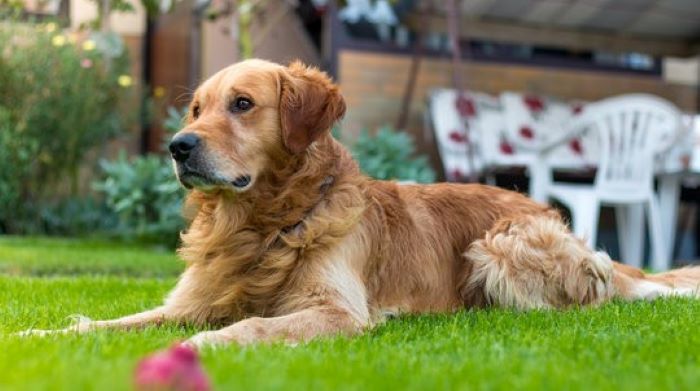
Gnats are attracted to moisture and organic matter, so they tend to target your dog’s eyes, nose, ears, wounds, or private parts. Gnats can cause itching, irritation, allergies, infections, and even diseases to your dog.
In this article, we will discuss four effective methods to prevent gnats from bothering your dog: using ointment on your dog’s ears, keeping your yard free of waste, using natural repellents on your dog’s coat, and avoiding gnat-infested areas.
By following these tips, you can protect your dog from gnats and make him happier and healthier.
Contents
How Can You Keep Gnats off Dogs?
Gnats are small flies that can bite and irritate your dog. They are attracted to moist and organic areas, such as your dog’s eyes, ears, or wounds. Gnats avoid marigolds whenever possible because, according to research, they can’t abide the scent of them.
Moreover, you may try applying sprays to your pet, such as those that combine cedarwood or neem oil at a 10:1 ratio with witch hazel or olive oil as a base. Gnats don’t like any of these substances.
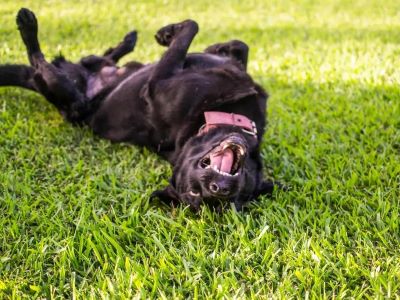
In this section, we will show you some ways to keep gnats off your dog and prevent them from causing harm.
Method #1 Use Ointment on Your Dog’s Ears
- One of the most common areas that gnats and flies target on your dog is the ears. Flies can bite your dog’s ears and cause bleeding and infection.
- This can be very painful and uncomfortable for your dog, and may lead to further complications if left untreated.
- To prevent fly bites on your dog’s ears, you can apply some ointment on the tips and top surface of the ears. A good option is petroleum jelly or Vaseline, which can create a barrier against the flies and soothe the irritated skin.
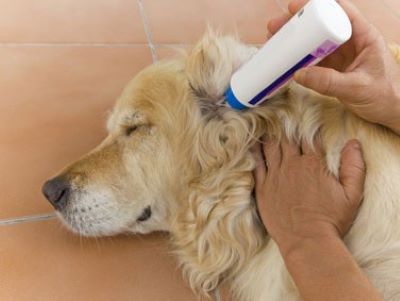
- However, you should be careful not to apply ointment to areas that your dog can lick off, as this can be harmful if ingested.
- You should also check your dog’s ears regularly for signs of infection or inflammation, and consult your veterinarian if needed.
Method #2 Keep Your Yard Free of Waste
- Another way to keep gnats off your dog is to keep your yard free of waste. Garbage, dog poop, dead animals, mold and fungi can attract gnats and flies, which can then find their way to your dog.
- To prevent this, you should keep your garbage cans empty and clean, picking up dog waste regularly, and removing any decaying organic matter from your yard.
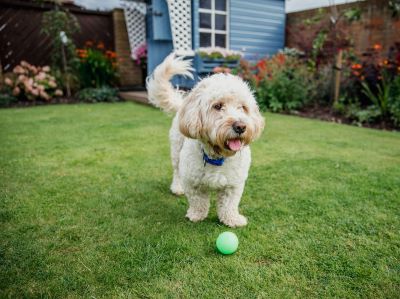
- You should also turn your mulch regularly, keep your compost away from your house, and seal your bins with insect repellents.
- These steps will help reduce the food sources and breeding grounds for gnats and flies, and make your yard less appealing to them.
Method #3 Use Natural Repellents on Your Dog’s Coat
- Besides keeping your yard clean, you can also use natural repellents on your dog’s coat to ward off gnats and flies.
- Some natural oils and plants have scents that gnats and flies dislike, such as eucalyptus, citronella, lavender, mint, and basil.[1]

- You can use a shampoo containing eucalyptus or citronella oil to wash your dog’s coat, or spray your dog with a diluted vinegar solution to make him less attractive to the pests.
- However, you should be careful not to use essential oils that can be toxic to dogs, such as tea tree, pennyroyal, or clove. These oils can cause skin irritation, vomiting, seizures, or even death in dogs.
- Always consult your veterinarian before using any natural repellents on your dog.
Method #4 Avoid Gnat-Infested Areas
- The last method to keep gnats off your dog is to avoid gnat-infested areas. Some of the common places where gnats tend to swarm are near water sources, thick grassy areas, or overripe fruit.
- These places provide moisture and organic matter for gnats to feed and breed on.
- You should avoid taking your dog for walks in these areas, especially during dawn and dusk when gnats are most active Instead.
- You can take your dog to alternative places where gnats are less likely to be found, such as indoor parks, trails, or beaches.
- These places can offer your dog more exercise and fun without the risk of gnat bites.
What are Gnats and Why are They Attracted to Dogs?
Gnats are tiny flying insects that belong to hundreds of species of flies. They are often mistaken for mosquitoes, but they are much smaller in size.[2]
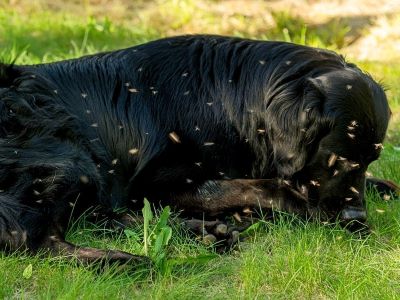
Some gnats bite and feed on warm blood, while others do not. However, they are all annoying and irritating to both humans and dogs.
Types of Gnats that Bite Dogs
There are different types of gnats that can bite dogs, such as:
1). Black flies or buffalo gnats: These gnats have a humpbacked appearance and are usually black or gray in color. They can leave red “bulls-eye” spots on a dog’s belly and can carry various parasites and diseases.
2). No-see-ums or biting midges: These gnats are very small and hard to see. They can cause intense itching and allergic reactions in dogs. They can also transmit diseases such as heartworms and leishmaniasis.
3). Fungus gnats: These gnats are dark brown or black and have long legs and antennae. They feed on fungus and organic matter in soil and plants. They can carry a rare disease called pythiosis that affects humans and pets.[3]
4). Eye gnats: These gnats are yellowish-brown and have short antennae. They are attracted to moisture or discharge from a dog’s eyes and can carry conjunctivitis.
5). Sand flies: These gnats are yellowish-brown or gray and have hairy wings. They are usually found on beaches or near water sources. They can cause painful bites and transmit diseases such as leishmaniasis and bartonellosis.
Factors that Attract Gnats to Dogs
Gnats are attracted to dogs for various reasons, such as:

- Moisture: Gnats need moisture to survive and breed. They are drawn to wet areas such as a dog’s eyes, nose, ears, wounds, or private parts.
- Smell: Gnats are attracted to the smell of organic debris and carbon dioxide. They can sense the odor of a dog’s breath, sweat, urine, feces, or blood.
- Heat: Gnats are attracted to the warmth of a dog’s body. They can detect the heat emitted by a dog’s skin or fur.
- Dirt: Gnats are attracted to dirt and grime on a dog’s coat. Dogs with greasy or dirty coats can attract more gnats than clean ones.
FAQs
Why are gnats attracted to my dogs?
Gnats are attracted to your dogs because they feed on warm blood and organic matter. They are drawn to the moisture and smell of your dog’s eyes, nose, ears, wounds, or private parts. They are also attracted to the carbon dioxide that your dog exhales.
What smell do gnats hate?
Gnats hate smells that are strong, bitter, or acidic. Some examples of smells that gnats hate are vinegar, lemon, citronella, eucalyptus, lavender, mint, basil, and vanilla.
What keep gnats away?
To keep gnats away, you can use natural or chemical repellents on your dog’s coat or collar, such as vinegar, vanilla extract, or DEET.
You can also keep your yard free of waste and moisture that can attract gnats, such as garbage, dog poop, dead animals, mold, fungi, or overripe fruit.
You can also avoid taking your dog to gnat-infested areas, such as near water sources, thick grassy areas, or compost piles.
What smell kills gnats?
There is no smell that can kill gnats directly. However, some smells can repel gnats or trap them.
For example, vinegar can repel gnats from your dog’s coat if you spray it diluted with water.
Vinegar can also trap gnats if you mix it with sugar and dish soap in a jar and poke holes in the lid. The gnats will be attracted to the sweet smell but will drown in the liquid.
Conclusion
We have learned how to keep gnats off dogs using four effective methods: using ointment on your dog’s ears, keeping your yard free of waste, using natural repellents on your dog’s coat, and avoiding gnat-infested areas.
By following these tips, you can protect your dog from gnats and prevent them from causing harm. Keeping gnats off dogs has many benefits, such as reducing itching, irritation, allergies, infections, and diseases.
It also makes your dog more comfortable and happy. Gnats are annoying and irritating pests that can ruin your outdoor fun with your dog. But with some simple steps, you can keep them away and enjoy your time with your furry friend.
Do you have any other tips or experiences with gnats and dogs? Feel free to share them in the comments below. We would love to hear from you!
References:
- Basilides, R. (2016). Plant-based insect repellents: a review of their efficacy, development and testing.- ACADEMIA
- Vallie, S. (2023, February 10). Gnats: What to Know. Retrieved June 19, 2023, from- WebMD
- Chen, C., Ma, H., Ma, M., Li, J., Zheng, S., Song, Q., Gu, X., Shapiro-Ilan, D. I., & Ruan, W. (2020). An innovative strategy for control of fungus gnats using entomopathogenic nematodes alone or in combination with waterlogging. Journal of Nematology, 52(1), 1–9.- sciendo

Dania is a dog groomer living in California, who loves styling dogs. She often uses dog accessories to keep them distracted while grooming. She is also a dog parent to a Pomeranian, Duke. It’s because of him she is always on a lookout for the best dog foods, toys, other dog accessories, and ways to keep him equipped, healthy and happy.

